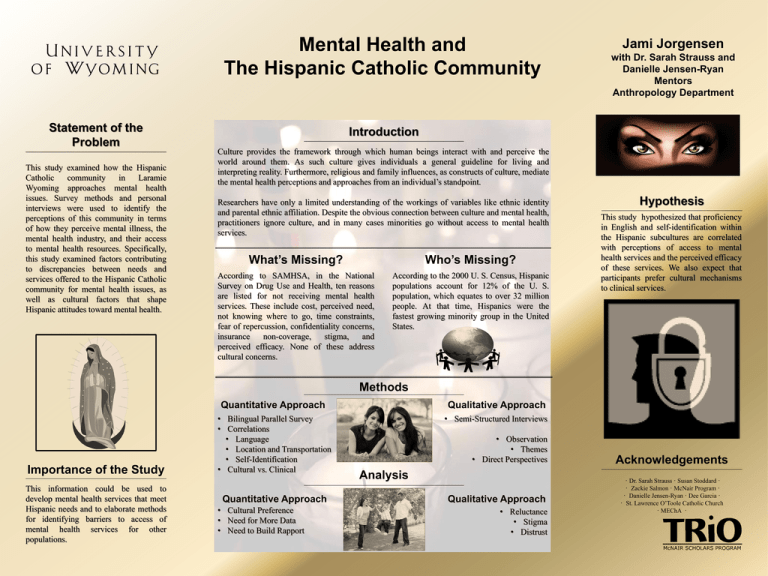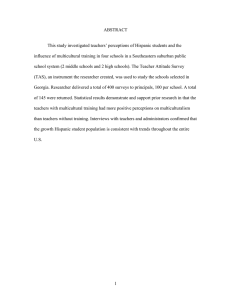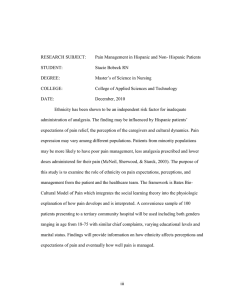Jami Poster for Cheyenne
advertisement

Mental Health and The Hispanic Catholic Community Statement of the Problem This study examined how the Hispanic Catholic community in Laramie Wyoming approaches mental health issues. Survey methods and personal interviews were used to identify the perceptions of this community in terms of how they perceive mental illness, the mental health industry, and their access to mental health resources. Specifically, this study examined factors contributing to discrepancies between needs and services offered to the Hispanic Catholic community for mental health issues, as well as cultural factors that shape Hispanic attitudes toward mental health. Jami Jorgensen with Dr. Sarah Strauss and Danielle Jensen-Ryan Mentors Anthropology Department Introduction Culture provides the framework through which human beings interact with and perceive the world around them. As such culture gives individuals a general guideline for living and interpreting reality. Furthermore, religious and family influences, as constructs of culture, mediate the mental health perceptions and approaches from an individual’s standpoint. Researchers have only a limited understanding of the workings of variables like ethnic identity and parental ethnic affiliation. Despite the obvious connection between culture and mental health, practitioners ignore culture, and in many cases minorities go without access to mental health services. What’s Missing? Who’s Missing? According to SAMHSA, in the National Survey on Drug Use and Health, ten reasons are listed for not receiving mental health services. These include cost, perceived need, not knowing where to go, time constraints, fear of repercussion, confidentiality concerns, insurance non-coverage, stigma, and perceived efficacy. None of these address cultural concerns. According to the 2000 U. S. Census, Hispanic populations account for 12% of the U. S. population, which equates to over 32 million people. At that time, Hispanics were the fastest growing minority group in the United States. Hypothesis This study hypothesized that proficiency in English and self-identification within the Hispanic subcultures are correlated with perceptions of access to mental health services and the perceived efficacy of these services. We also expect that participants prefer cultural mechanisms to clinical services. Methods Importance of the Study This information could be used to develop mental health services that meet Hispanic needs and to elaborate methods for identifying barriers to access of mental health services for other populations. Quantitative Approach Qualitative Approach • Bilingual Parallel Survey • Correlations • Language • Location and Transportation • Self-Identification • Cultural vs. Clinical • Semi-Structured Interviews Quantitative Approach • Cultural Preference • Need for More Data • Need to Build Rapport • Observation • Themes • Direct Perspectives Analysis Qualitative Approach • Reluctance • Stigma • Distrust Acknowledgements · Dr. Sarah Strauss · Susan Stoddard · · Zackie Salmon · McNair Program · · Danielle Jensen-Ryan · Dee Garcia · · St. Lawrence O’Toole Catholic Church · MEChA ·



